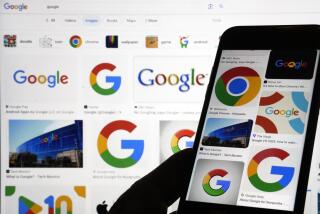Hacking the iPhone
For the past few weeks, exceptionally geeky gadget lovers have been celebrating a series of breakthroughs in the pursuit of one of their Holy Grails: opening the Apple iPhone to software applications not written or approved by Apple. Their dedication and success is a harbinger of things to come for the wireless industry, which is headed, kicking and screaming, into a long and fitful transition from central control to user liberation. That transition is being fueled by devices such as the iPhone, and by federal regulators, who imposed unprecedented requirements for openness last week on a new generation of wireless services.
The iPhone -- called the Jesus Phone by some, in light of its worshipful following -- shares many of the same handicaps that bedevil other U.S. cellular devices. It can be used on only one mobile network (AT&T’s, or more specifically AT&T’s second-tier data network). And while users can put song files, pictures and TV shows onto their iPhones, they can’t install software (or ringtones, oddly enough -- at least not yet). That means no Skype, for example, or any other service that requires specially installed software.
But Apple did carve out a doggy-door into the iPhone. It invited developers to create web-based applications and services that the iPhone could run in its browser. Developers responded with an array of offerings, including online news readers, instant-messaging programs and even voice-over-IP services. The main drawback is that the programs and services work only while the iPhone is connected to a WiFi access point or AT&T’s poky data network.
That’s much more freedom to develop and customize than other phones allow, mainly because their Web browsers don’t measure up to Apple’s Safari. Yet it still wasn’t enough for some critics, who complained that even Safari offered too limited a set of software-writing tools. Potential innovators would be handcuffed without being able to tap the phone’s full computing power, the argument went.
That’s why a loosely organized group of code-writers started hacking their way into the heart of the iPhone, trying to write applications that could be installed and operated on the phone the same way programs can be loaded onto a Mac. So far, they’ve developed several basic applications, starting with one that displayed a two-word message on the iPhone screen: “Hello world.” (If that sounds pointless, bear in mind where the phrase has been used before.) Among the current crop of iPhone-able applications is an an open-source program to feed content onto the Web.
These hacks require more technical know-how than the vast majority of mobile-phone customers have. But if someone develops an application that the masses might find compelling, a version will surely follow that’s simple enough for the masses to use. And as the number of iPhone users grows -- Apple’s target is 10 million by the end of 2008 -- so, too, will the incentive for developers to try to fashion a killer app.
This pattern is familiar to anyone who watched the rise and fall of America Online. In the early days of ISPs, the alien complexity of computers and the ‘Net led millions of users to crave the simplicity that AOL offered inside its “walled garden,” or private network. But while AOL was keeping a tight lid on what was available on its network, entrepreneurs had complete freedom to develop sites and services on the public Internet. Eventually, AOL’s users found more to like on the unrestricted Web than they could within the safety and comfort of AOL’s walled garden.
Wireless network operators have revived the walled-garden model in an effort to wring more cash out of their customers. Verizon Wireless is probably the most extreme example; it disables features on its phones, blocks numerous third-party services and even tries to collect extra fees for transferring pictures from a cellphone to a PC. This approach might be sustainable as long as mobile phones are primarily phones, but the iPhone represents something different: an all-purpose device for staying connected. It’s a mobile Internet terminal as much as it is a cellphone, and Internet users don’t like to be fenced in by their ISPs.
The Federal Communications Commission acknowledged as much last week when it set the rules for auctioning a portion of the airwaves once reserved for UHF TV signals, technically known as the 700 MHz band. While police and firefighters will get first crack at a portion of those frequencies, most of the band is expected to be used to offer wireless high-speed Internet access service. The FCC had imposed few rules on wireless operators in the past, under the theory that competition in the market would yield better results than regulation. But in a contentious shift, the commission placed a new burden on a slice of the 700 MHz band frequencies large enough for a new national broadband network: it required the winning bidder(s) to open the network to compatible devices and applications from any source.
The goal, as stated by FCC Chairman Kevin Martin, is to spur innovation. Removing the network operator’s ability to bless or reject devices could throw the market open to anyone with a novel idea or business model. The same may be true for application developers, such as Skype and Google, who have been pressing the FCC for this kind of open access (in Skype’s case, not just in the 700 MHz band, but for mobile phone networks as well). At a congressional hearing last month, entrepreneur Jason Devitt laid out several examples of services currently missing from mobile phone networks that independent developers might be more capable or motivated to offer in an open-network environment, such as more location-based services.
Skeptics say that Martin undermined his own efforts by not imposing rules that would prevent the current mobile phone operators, such as Verizon and AT&T, from gobbling up the new licenses. Those companies have a huge incentive to outbid rivals who might compete with their lucrative high-speed Internet services, and they can price and package their services in the 700 MHz band in ways that render the new requirements meaningless (for starters, by subsidizing their own devices so heavily that no independent manufacturer could compete).
Still, as the iPhone and its hacks illustrate, the pressure for openness on the wireless networks is building, and moving to higher data speeds will only intensify it. Look at the meteoric rise of the original Napster, the iTunes Music Store and YouTube. A good idea, with or without the support of the affected industry, can rapidly build an audience of millions, and change paradigms. The new requirements on part of the 700 MHz band should make it easier for device-makers and applications developers to let the market judge the value of their ideas. And if they’re really good, network operators would be better off letting these innovations increase the demand for their airwaves, rather than trying in vain to wall them off.
Jon Healey is a member of The Times’ editorial board and author of the BitPlayer blog. Send us your thoughts at [email protected].
More to Read
A cure for the common opinion
Get thought-provoking perspectives with our weekly newsletter.
You may occasionally receive promotional content from the Los Angeles Times.











